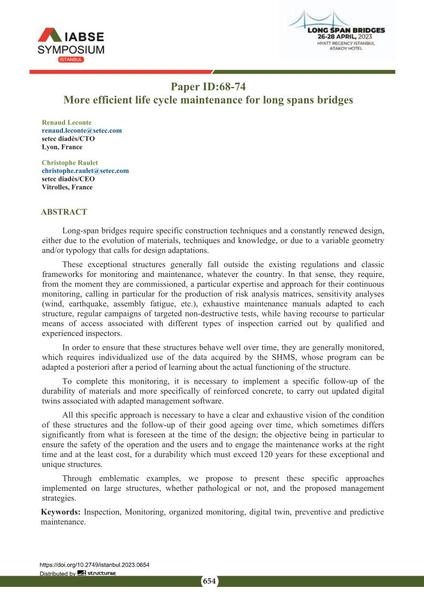More efficient life cycle maintenance for long spans bridges

|
|
|||||||||||
Détails bibliographiques
| Auteur(s): |
Renaud Leconte
(setec diadès/CTO, Lyon, France)
Christophe Raulet (setec diadès/CEO, Vitrolles, France) |
||||
|---|---|---|---|---|---|
| Médium: | papier de conférence | ||||
| Langue(s): | anglais | ||||
| Conférence: | IABSE Symposium: Long Span Bridges, Istanbul, Turkey, 26-28 April 2023 | ||||
| Publié dans: | IABSE Symposium Istanbul 2023 | ||||
|
|||||
| Page(s): | 654-664 | ||||
| Nombre total de pages (du PDF): | 11 | ||||
| Année: | 2023 | ||||
| DOI: | 10.2749/istanbul.2023.0654 | ||||
| Abstrait: |
Long-span bridges require specific construction techniques and a constantly renewed design, either due to the evolution of materials, techniques and knowledge, or due to a variable geometry and/or typology that calls for design adaptations. These exceptional structures generally fall outside the existing regulations and classic frameworks for monitoring and maintenance, whatever the country. In that sense, they require, from the moment they are commissioned, a particular expertise and approach for their continuous monitoring, calling in particular for the production of risk analysis matrices, sensitivity analyses (wind, earthquake, assembly fatigue, etc.), exhaustive maintenance manuals adapted to each structure, regular campaigns of targeted non-destructive tests, while having recourse to particular means of access associated with different types of inspection carried out by qualified and experienced inspectors. In order to ensure that these structures behave well over time, they are generally monitored, which requires individualized use of the data acquired by the SHMS, whose program can be adapted a posteriori after a period of learning about the actual functioning of the structure. To complete this monitoring, it is necessary to implement a specific follow-up of the durability of materials and more specifically of reinforced concrete, to carry out updated digital twins associated with adapted management software. All this specific approach is necessary to have a clear and exhaustive vision of the condition of these structures and the follow-up of their good ageing over time, which sometimes differs significantly from what is foreseen at the time of the design; the objective being in particular to ensure the safety of the operation and the users and to engage the maintenance works at the right time and at the least cost, for a durability which must exceed 120 years for these exceptional and unique structures. Through emblematic examples, we propose to present these specific approaches implemented on large structures, whether pathological or not, and the proposed management strategies. |
||||
